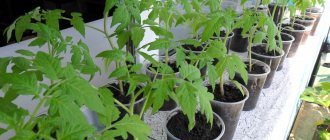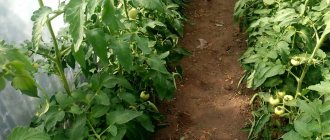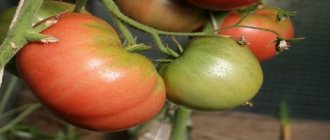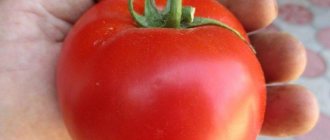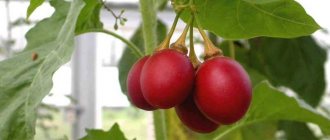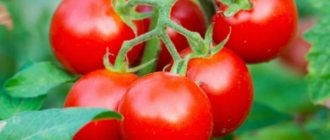Tomato "Watermelon": description of the variety
| Variety name | Watermelon |
| general description | Mid-season indeterminate variety |
| Originator | Russia |
| Ripening period | 107-113 days |
| Form | Round, flattened at the stalk, well-defined ribbing |
| Color | Dark red fading to brown |
| Average weight of tomatoes | 145-165 grams |
| Application | Salad variety |
| Productivity of the variety | 4.8-6 kg per sq.m |
| Features of cultivation | Standard agricultural technology |
| Disease resistance | Resistant to major diseases |
The Watermelon variety is included in the State Register of Russia.
It is recommended to grow tomatoes in a greenhouse. Planting seedlings in open ground is possible only in the south of Russia. Mid-early ripening tomato. You can pick the first tomatoes of unusual color 107-113 days after planting the seeds for seedlings. The bush of the plant is of an indeterminate type, grows up to 190-210 centimeters. The number of leaves is above average, the usual shape for tomatoes, dark green in color. The name of the variety was given for the appearance of the tomato at the ripening stage. The striped coloring of tomatoes is noticeable. Just as the seeds are clearly visible when cutting a watermelon, the seeds are visible when cutting through a tomato.
The best yield results are obtained when the bush is formed with one stem, with the obligatory garter to the support. It is advisable to remove leaves below the first cluster of formed fruits. This enhances the ventilation of the soil in the hole and prevents diseases from developing in conditions of high humidity.
The “Watermelon” tomato variety is characterized by a long fruiting period; according to many reviews received from gardeners, it has a fairly high resistance to late blight and fungal infections of tomatoes.
On our website you will find a lot of useful information about growing tomatoes. Read all about indeterminate and determinate varieties.
And also about the intricacies of caring for early ripening varieties and varieties characterized by high productivity and disease resistance.
Diseases and pests
The tomato variety “Watermelon” has excellent immunity to late blight and fungal diseases. However, as a preventive measure, at an early stage of the growing season, the bushes are treated using special preparations.
ATTENTION: When the first signs of the disease appear, tomato plantings are sprayed with a solution of the preparations “Zaslon”, “Oxyx”, “Barrier”. Effective preventive measures against insect pests - wood ash, tobacco dust, the use of special preparations.
Rules for growing tomatoes
Plants of the Watermelon variety can be grown not only in a greenhouse, but also in open ground. To do this, they are given a well-lit area with fertile soil. In the fall, before digging, a bucket of rotted manure or vermicompost is added to each square of the bed area. If the soil is clayey, add sand to loosen it.
To prevent tall bushes from being torn by the wind, the tomatoes are protected with curtains of corn. It will be successful to plant the crop along a fence or building on the south side.
Planting seedlings
Tomatoes similar to watermelon are sown 2 months before the expected date of planting in a permanent place. Depending on the climate of the region and the method of cultivation (in a greenhouse or outdoors), Watermelon is sown from February to April.
Seeds purchased in the store have already been treated for diseases. They are germinated in a damp cloth for 2-3 days. If the seeds are old, Epin's solution can stimulate their development. Planting material collected from your tomatoes must be pickled in a pink solution of potassium permanganate or Fitosporin.
Tomatoes ready for sowing are immersed in the soil to a depth of 1 cm. Tall varieties are grown in separate pots, and as they grow, the seedlings are transferred to a large container. You can use peat tablets for sowing, after soaking them in warm water. Seedlings in tablets at the age of 1 month are planted in a regular 1 liter pot and covered with soil.
Seedling substrate for tomatoes is prepared from a mixture of forest soil, sand (vermiculite), and peat. Some gardeners buy peat substrate in the store and enrich it with humus. In addition to humus, mix 2 tbsp into 5 liters of soil. l. complex mineral fertilizer for tomatoes. Before applying fertilizer, the self-made mixture is steamed or roasted in the oven to get rid of mold.
Watermelon seedlings are kept on a bright windowsill, at a temperature of +20 +24 degrees, protected from drafts.
Tomato transplant
Tomato seedlings are planted in the ground when it warms up to +15 degrees. The plant does not tolerate temperature drops down to +2 degrees - it freezes. If frosts are expected after planting tomatoes in the garden, the bushes are wrapped in blankets and covered with sawdust and straw. If the tops of the tomato are frozen, new stems are formed from the side shoots.
The scheme for planting Watermelon in a greenhouse is 40 by 40 cm. In open ground, where a bush of 2 stems is often formed, the tomato is planted more spaciously, half a meter apart. It is recommended to deepen (plant the seedling “lying down”) the plant to the first leaves. New roots will soon form on the buried stem, and the nutrition of the tomato will improve. This will give a yield increase of 25%.
Preparing for landing
Before planting seedlings in the ground, it is worth hardening them off. The method of adjusting the temperature in the room where it is located received excellent reviews. During the day it should be raised to 19 degrees Celsius, and at night it should be lowered to no lower than 17 degrees Celsius. After this, you can move the seedlings to the greenhouse, planting them in a checkerboard pattern following a pattern of 40 X 60 centimeters.
This way you will provide enough space for the plants to grow, and during harvesting and when tying up bushes you will feel all the benefits of this arrangement. The seedlings that you plant in the ground must be carefully removed from the pots, leaving a little soil on the roots.
Growing rules
The Watermelon tomato variety is grown using seedlings. Seeds are planted in early spring at home. When the tomatoes grow and get stronger, they are transferred to a permanent place. During the growing season, tomatoes are regularly watered, fed, and planted.
Planting seedlings
Watermelon tomato seeds are planted in March-April. Boxes or cups are prepared for them, which are filled with a mixture of peat and sand. The substrate is also obtained by combining peat, humus and sawdust in a ratio of 6:6:1. The soil is disinfected in the oven, and 2-3 weeks before planting the seeds, it is watered with a solution of the EM-Baikal preparation.
Advice! It is convenient to use peat cups for planting tomatoes. 2-3 seeds are placed in each of them.
The planting material is buried 3-4 mm and covered with plastic film on top. Then the containers are moved to a dark, warm place. Seeds germinate at temperatures above 20 °C. Periodically, the polyethylene is removed to remove condensation and provide fresh air. When shoots appear, the boxes are moved closer to the light source. If containers are placed on a windowsill, foam plastic is placed under them so that the plantings are not damaged by the cold.
Tomato seedlings of the Watermelon variety are provided with constant care:
- maintain the temperature at 20-25°C during the day and 15-17°C at night;
- regularly ventilate the room;
- turn on the backlight so that the plantings are illuminated continuously for 10-12 hours;
- Spray the soil with a spray bottle every week.
When tomatoes have 2-3 leaves, they are picked into different containers
First, the soil is well moistened, then the seedlings are carefully separated and transferred to a new location. You can use the same substrate as when planting seeds
Tomato transplant
Tomatoes are transplanted into open ground or a greenhouse at the age of 1-1.5 months. Such plants have a strong stem 30 cm high and 7-8 leaves. 2-3 weeks before transferring them to open ground or a greenhouse, they begin to harden the tomatoes. First, open a window in the room for 3-4 hours. Then they move the containers to the balcony or loggia. Tomatoes adapt to natural conditions and cope better with transplantation.
The soil for planting tomatoes is prepared in the fall. The beds are dug up and fertilized with rotted manure. Tomatoes require natural light and protection from the wind. The best predecessors for the crop are cabbage, legumes, onions, beets, and carrots. It is not recommended to plant the Watermelon variety after eggplants, potatoes, peppers and tomatoes.
Tomatoes are planted in a permanent location in May. Holes are prepared in the garden bed to suit the size of the root system. For 1 sq. m place no more than 3-4 tomatoes. Leave 40 cm between bushes, 60 cm between rows
The plants are carefully removed from the containers and transferred to the hole. The roots are covered with soil and watered abundantly. Within two weeks, tomatoes adapt to new conditions, so they are not fed
Within two weeks, tomatoes adapt to new conditions, so they are not fed.
Subsequent care for tomatoes
According to gardeners, the Watermelon tomato variety needs constant watering. Before the ovaries appear, moisture is added every week in the amount of 5 liters per bush. During fruiting, the frequency of watering is increased to 2 times a week, however, the consumption will be 3 liters per plant. Use only warm, settled water. To reduce the number of waterings, the soil under tomatoes is mulched with humus, peat or straw.
Regular fertilizing stimulates the growth of tomatoes and increases productivity. Organic and mineral fertilizers are used for the Watermelon variety. It is best to alternate different types of treatments.
Feeding scheme for Watermelon tomatoes:
- 20 days after planting in the garden - 1 tbsp. l. Nitrophoska and 0.5 liters of mullein per bucket of water;
- during flowering - 30 g of superphosphate and potassium sulfate per 10 liters of water;
- when fruiting tomatoes – 2 tbsp. l. superphosphate and 1 tsp. sodium humate per bucket of water.
Every week, stepsoning is carried out. The shoots are broken off by hand. The plant is formed into 1 stem. At the end of the growing season, pinch off the growing point. Since the Watermelon variety reaches a height of 2 m or more, it is tied to a metal or wooden support. It is convenient to use trellises in a greenhouse.
Rules for growing the variety
To get a high yield of tomatoes, you need to grow seedlings in advance. It is planted in early March. Before planting, low-quality seeds are discarded. To do this, the grains are placed in a saline solution. Those seeds that have sunk to the bottom of the liquid are suitable for planting.
Then the seed material is disinfected. The seeds are dipped into a weak, slightly pink solution of potassium permanganate for 30 minutes. Then they are dried.
It is important to prepare the soil in which the seedlings will be planted. You can purchase it at a specialty store or prepare it yourself.
It is necessary to combine 6 parts of peat, 6 parts of humus, sand and sawdust. All components are mixed and containers are filled with soil. If the soil is taken from the garden, it is doused with boiling water for disinfection purposes.
The seeds must be buried 1 cm. After planting, they are sprinkled with earth and lightly watered. The containers are covered with glass or film. Place them in a warm place. When the seeds germinate, the coverings are removed and the containers are placed on the windowsill on the south side. Now the sprouts need a lot of sunlight. The optimal temperature for high-quality growth will be +22 degrees and above.
As soon as the plants have 2-3 leaves, pick them. The essence of this method is to plant each plant in a separate container.
Transplanting tomatoes into open ground
Tomatoes are planted in open ground when the seedlings are 1-1.5 months old. The soil is prepared in the fall. Organic fertilizers are applied to the beds and the soil is dug up. You need to choose a sunny place, protected from the wind. It is advisable to choose beds where carrots, legumes, cabbage, onions, and beets used to grow. The Watermelon variety is not planted in beds where eggplants, peppers and other varieties of tomatoes grew.
It is recommended to plant tomatoes in May. The bed is dug up again. Make holes 15-20 cm deep. A distance of 20 cm should be left between each plant. There should be a distance of 60 cm between the rows. The plants are sprinkled with earth and watered abundantly.
Advantages and disadvantages of the plant
The Watermelon tomato variety has many positive qualities:
- Original shape and coloring;
- Rich tomato taste;
- Long-term fruiting;
- Easy to care for;
- Disease resistance;
- Versatility in use;
- Good yield.
But there are also several significant disadvantages that should be taken into account while expecting a good result:
- Does not withstand transportation;
- Not suitable for conservation;
- Not intended for long-term storage;
- The fruits are prone to cracking.
Only after studying all the features of the Watermelon tomato, weighing the pros and cons of this variety, can you start growing it
If you pay due attention to caring for the plant, show a little hard work and patience, it will reward you with excellent taste.
The Watermelon tomato is valued for its decorative appearance. Smooth, neat fruits are pleasant not only to eat, but also to contemplate in the garden. Their taste, judging by the annotation, is also at a high level. Due to this, medium-sized tomatoes are used in slices, sauces, and whole-fruit canning.
Other positive characteristics of tomato:
- a variety of growing methods - an open area in the garden, a temporary or permanent greenhouse;
- resistance to a complex of tomato diseases;
- good keeping quality and transportability;
- uniformity of tomatoes, simultaneous ripening;
- high yield with any cultivation method;
- long period of fruiting - until autumn frosts.
There are also disadvantages:
- High growth. You need a strong fixation of heavy hands on the support.
- Susceptibility to late blight. The timing of ripening coincides with the seasonal outbreak of the disease.
- The need for additional manipulations in the garden. The plant needs to be shaped. Preferably - in 1-2 stems.
- Further care consists of regular grooming.
Reviews, who planted
Since the “Watermelon” variety is more demanding, it requires neutral or slightly acidic soil. Despite this feature, gardeners prefer to grow the Watermelon tomato due to its excellent taste characteristics, ease of care, good harvest and long fruiting period.
Those gardeners who have not yet grown the “Watermelon” tomato variety should try planting it in their garden plot, providing themselves with fresh tomatoes until frost. Thanks to its ease of care, even novice gardeners can grow the Watermelon tomato.
Description and characteristics of the variety
- The Watermelon variety is included in the State Register of the Russian Federation.
- Created for cultivation in greenhouse conditions. However, in the south of Russia with a warm climate, such tomatoes can also be grown in open ground.
- Mid-early ripening period. You can enjoy the first ripe tomatoes 105-115 days after seed germination.
- Indeterminate. The bush is not limited in growth and can grow in height up to 190-210 cm.
- Not standard. It is necessary to remove excess stepsons. The main thing is to pinch them, leaving a 5-7 mm stump so as not to damage the main stem.
- Foliage is above average. The leaves are dark green. Their shape is normal, like most tomatoes.
- The variety was named Watermelon due to the appearance of the tomatoes during ripening. The striped coloring is clearly visible on the fruits. Inside there are large seeds that are clearly visible when cutting the fruit.
- It is better to form bushes into 1 stem. This way you can get a larger harvest.
- A mandatory garter to the support is required as the stem grows. You should not grow the plant over 2 m. It is better to pinch the top during the growing season so that the tomatoes receive all the necessary nutrients.
- The inflorescences are ordinary, the first ones are formed over 8-9 leaves, all subsequent ones - over every 3-4 leaves.
- Below the start of the first cluster, it is recommended to remove all leaves to improve air circulation around the hole. Such measures help reduce the risk of developing diseases characteristic of nightshades when exposed to high humidity.
- Long-term fruiting. Tomatoes will appear on the bushes until frost, when there is practically nothing left in the garden. This is very convenient, as it allows you to consume vitamin-rich tomatoes until late autumn.
- Resistance to major tomato diseases, such as late blight and fungal infection of fruits.
- Productivity is average. From 1 bush you can harvest 2-2.5 kg of tomatoes, from 1 sq. meter, the yield is 5-6 kg, provided that no more than 3 bushes are grown in this area.
Productivity
The yield from one bush varies from 2.2 to 2.5 kg. The average yield per 1 m2 when planting no more than three seedlings is 4.8-6.0 kg.
The “Watermelon” variety is more recommended for cultivation in greenhouse conditions. However, in regions with warm climates it can be grown in unprotected soil.
When registered in the register, the variety was classified as a greenhouse variety. Therefore, the Watermelon tomato can be safely grown in all regions of the country. And in the southern regions (Krasnodar Territory, Rostov Region, Crimea) the bushes feel comfortable in open beds. The main thing is to provide them with good support.
Features of tomato care
Many reviews of the Watermelon tomato say that the variety does not require special care. Like all tomatoes, the crop responds well to organic feeding. During the flowering and ovary period, mineral fertilizers are needed. For better plant development, as well as to prevent diseases, the soil under the bushes needs to be loosened more often. The garden bed should not be overgrown with weeds. If possible, watering is organized with warm water, and it should be poured under the roots.
Any excess shoots that appear are removed from the plant. This is done when the shoots grow more than 4–5 cm in length. Tying the stems to a support is mandatory. For tall tomatoes, it is better to install trellises. In addition to the stems themselves, I tie branches with tassels to the support, otherwise they will break off from heavy fruits.
Preventative spraying is always welcome. The simplest solution of Bordeaux mixture will prevent the development of such a dangerous disease as late blight. A decoction of wormwood, soap solution or tobacco dust will help in the fight against spider mites, aphids, and whiteflies.
As you can see, the crop is easy to care for, and reviews of the Watermelon tomato will help vegetable growers decide to grow this variety on their plot.
General information
The Watermelon variety is included in the State Register of Russia, which means that tomatoes are recommended for cultivation in our climate. However, residents of a number of regions with short summers plant these tomatoes only in greenhouse conditions. Gardeners in the Russian south and Central Russia can safely plant Watermelon tomatoes in open ground.
The variety belongs to the category of vegetables with an average ripening period and long fruiting. There are not many leaves, but the branches grow up to two meters. It is clear that the Watermelon variety needs staking and pinching.
Have questions?
Ask and receive useful advice from professional gardeners and experienced summer residents.>>
The lower leaves also need to be trimmed. This is done solely for the sake of unhindered air circulation at the base of the bushes. All foliage below the first cluster must be cut off from each branch. They do more harm than good. These leaves shade the lower fruits on the stems and the soil under the bushes. As a result, a favorable environment is created for the activation of the vital activity of fungal microorganisms, including root rot spores. However, with careful care, these tomatoes rarely get sick.
Agricultural technology and cultivation features
Advice. For 1 sq. m, plant no more than 3-4 specimens, depending on the number of stems left.
Reviews of the Watermelon tomato are rare in thematic gardening communities. Information about it is posted by private breeders and seed collectors. The cost of planting material is quite high - 50-60 rubles. per package. Vegetable grower Dmitry Gusev notes the stable yield and high resistance of tomatoes to ailments. The variety has been in his collection since the early 90s.
This amateur variety was bred quite a long time ago, has interesting properties, but is not very common among domestic gardeners. Due to their decorative appearance, the cost of seeds is higher compared to other productive tomatoes.
The Watermelon variety of tomato is grown in seedlings. This process can be divided into several stages:
- Sowing tomato seeds;
- Picking seedlings;
- Planting bushes;
- Caring for tomatoes (watering, pinching, pinching, hilling);
- Feeding, protection from diseases.
Note! Sowing should be done approximately 50-60 days before the planned planting of seedlings in the ground (mid-March). Healthy seedlings are the first step to a good future harvest. The first thing to do is prepare the right soil
A ball of sand, or perhaps expanded clay, is poured into the bottom of the container and filled with soil. You can prepare the soil yourself by mixing garden soil with humus, sand, and ash. A ready-made peat mixture will also work. To disinfect, you can bake the soil for several minutes in the oven.
The first thing to do is prepare the right soil. A ball of sand, or perhaps expanded clay, is poured into the bottom of the container and filled with soil. You can prepare the soil yourself by mixing garden soil with humus, sand, and ash. A ready-made peat mixture will also work. To disinfect, you can bake the soil for several minutes in the oven.
The next step is preparing the seeds. If there is a colored shell (upon purchase), the seeds do not require additional processing. If the grains are not protected, it is better to pre-soak them in a solution of potassium permanganate.
Features of cultivation
Before sowing, it is recommended to moisten the soil with slightly warm water. Grooves are made at a distance of several centimeters, seeds are planted in them, and compacted a little. The containers are covered with film and placed in a warm room with good lighting. Every 2 days the soil should be moistened by spraying. When shoots appear, the film is removed.
You can plant seedlings in a garden bed if there are up to 10 leaves, the first crown. But you need to take into account that the air temperature should be at least 15 degrees, and the possibility of frost is minimal.
The land is being prepared for planting bushes.
It is important to know! Watermelon tomatoes do not tolerate acidic soils well; they prefer soil with neutral acidity. This variety of tomatoes is suitable for growing in a greenhouse and in open ground (subject to comfortable weather conditions). But it’s worth thinking about supports in advance
But it’s worth thinking about supports in advance
This variety of tomatoes is suitable for growing in a greenhouse and in open ground (subject to comfortable weather conditions). But it’s worth thinking about supports in advance.
Tomatoes are planted in holes at the rate of 3-4 bushes per square meter in a checkerboard pattern. They tie up immediately.
In the subsequent period, the tactics of caring for the Watermelon tomato are not much different from caring for other similar varieties.
Basically the process consists of the following steps:
- Proper watering. It is better to use drip watering or moisten the bush carefully at the root. Do not use the sprinkling method;
- Stepsonning. It is necessary to remove the stepsons and form a bush with 2, maximum 3 stems;
- Topping. Excess inflorescences that do not have time to ripen should be removed. When the height of the bush reaches 2 m, you can stop the growth of the plant by pinching the stem;
- Regular hilling. Loosening the soil helps the root system to breathe, supplies the tomato with moisture and nutrients;
- Constant tying. Due to the high growth of the bush and large fruits, the plant is unstable and can be easily damaged.
Advice. Avoid direct sunlight and rain on tomato bushes. The fruits may crack and the leaves may turn black.
The Watermelon tomato is quite resistant to diseases, but can be affected by late blight (treated with Bordeaux mixture), blossom end rot (calcium nitrate is used).
Best reviews from our readers
- Alexandra
City: IvanovoManufacturer: Gavrish
Where grown: Greenhouse
We liked it, just eat for pleasure. My mother gave me expired seeds from 2015, they sprouted 100%. There were 6 bushes, 2 per hole and 2 stems. I tied the first bunches and the second ones, then while it was hot it bloomed, but didn’t pour out the fruits, as I slept and collected the ripened ones. I tied 3-4 clusters or more of tomatoes in September. I still eat. The fruits are of different sizes.
- Antonina
Moscow cityManufacturer: Gavrish
Where grown: Greenhouse
Excellent tomato!!!! Very tasty, sweet, the bush is really two meters!!! The fruits are large, of course I didn’t weigh them in grams, I don’t know for sure, but if you don’t tie the ovaries, they bend and break. I’ll definitely plant it next year; it’s the most optimal variety for the greenhouse; the salad is the most delicious of them all. Of course, we feed our tomatoes everything we don’t mind)))) Just kidding, everything is done according to technology, we love and cherish it...
- Victoria
City: Perm regionManufacturer: Gavrish
Where grown: Greenhouse
A good yielding variety, large tomatoes, resistant to diseases, there were no problems with seedlings. I really like how the seedlings look before planting, the leaves are very delicate, really like a watermelon)
- Nina
City: Moscow regionWhere grown: Greenhouse
I’m very pleased, at first there were really double flowers, I didn’t remove everything, the first fruits were clumsy, but then I was pleased! I will definitely plant it!
The Watermelon tomato is the result of domestic selection. It is valued for its tasty and large fruits. The seeds are planted on seedlings, which are transferred to open ground. Tomatoes are constantly looked after: watered, fed, formed into a bush.
Features of care
After planting in the garden, the young “watermelons” are watered abundantly and the stems are immediately tied to the supports. In a greenhouse, a tomato bush is formed into 1 stem, mercilessly removing all the stepsons. All leaves up to the first flower cluster must also be removed. Outdoors, tomatoes are grown in 2-3 stems, pinching the top at a height of 1.5 m.
Water the Watermelon abundantly, allowing the plant to actively grow, 2-3 times a week. After filling the fruits, the amount of moisture is reduced to 1 time per week. Tap liquid is not used due to chemical additives. It must be kept for 2 days in an open container to release the chlorine.
To make work easier on tomato beds, you can install a drip irrigation system. Warm water, flowing through the sleeves directly into the tomato tree trunk area, effectively saturates the roots with moisture. Water savings with this irrigation system are 30%.
Tall tomatoes need regular feeding. Watermelon is fed every 2 weeks, starting from the moment the seedlings are planted in the garden. Approximate scheme of plant feeding:
- infusion of chicken manure, 1 liter per bush;
- infusion of weeds + ash + iodine, 1.5 liters per bush;
- complex mineral fertilizer with microelements, spraying;
- infusion of bread or yeast, 1.5 l;
- complex fertilizer or a mixture of superphosphate and potassium sulfate, 20 g and 15 g per 10 l;
- infusion of ash, 1.5 liters per bush.
You can fertilize tomatoes at the root only in moist soil. Without pre-watering, the nutrient solution may burn the roots.
Fruit
The fruit shape of this variety is elongated, slightly flattened. There are slightly noticeable “ribs” near the stem of the tomatoes, as in the photographs. At the top of a fully ripened fruit, a light brown spot is clearly visible. The bottom of each tomato remains dark green. Between these spots there are longitudinal stripes.
The yield of watermelon tomatoes is not that high, but at least 2.5 kg of very large, extremely tasty fruits are collected from each bush. In order for the tomatoes to be larger, you should not plant more than three bushes per square meter.
Harvest ripe tomatoes carefully as they are prone to cracking. Tomatoes of this variety look simply wonderful, but, unfortunately, are not suitable for long-term fresh storage and, as a result, for long-distance transportation
The skin on them is too weak for this
Tomatoes of this variety look simply wonderful, but, unfortunately, are not suitable for long-term fresh storage and, as a result, for long-distance transportation. The skin on them is too weak for this.
The taste of the Watermelon tomato is excellent. Salads and various dishes are prepared from them. They make delicious juice and seasonings, but due to their large size and weak skin, they cannot be pickled.
It is also important that Watermelon tomatoes ripen gradually; this process drags on throughout the summer. This means that you will always have fresh tomatoes at your table, so stock up on vegetable salad recipes
In addition, ripe fruits hang on the branches for a long time, although their flesh is tender.
The main drawback of the variety, judging by the reviews, is that the picked tomatoes need to be processed or eaten as quickly as possible, otherwise they will leak.
Growing
The Watermelon tomato is very heat-loving. In the south, the seeds, which, by the way, are produced, are planted directly in the garden bed, but for central Russia this option is unacceptable. Here, gardeners even cover the bushes with film and leave it for at least a week until the bushes begin to actively grow.
Seeds are planted for seedlings in mid-March, then the first fruits ripen by July. There is one peculiarity when sowing seeds of this variety. They should not be sown in a common container; it is better to immediately divide them into separate cups or peat tablets. The seedlings are turned daily so that they do not lean toward the light source. The soil should always be just slightly moist, but not soggy.
A month before transplanting seedlings, prepare the soil. Dig up the beds with the addition of humus. If the soil is heavy, add sand. After this, prepare the holes for the seedlings. They should be located at least 40 cm apart from each other. The gaps between the rows are about 60 cm. Immediately before planting the sprouts, add one spoon of sifted wood ash and dry mineral fertilizers to each hole. Pre-mix both components until smooth.
Rules of care
It is very important to know that during flowering and fruit set, this variety needs fertilizing with mineral fertilizers. The second important point is that it is recommended to regularly loosen the soil under these tomatoes, not to mention weeding
Water the watermelon tomatoes only at the root with warm, clean water.
Despite the incredible resistance to diseases, it doesn’t hurt to sometimes spray the Watermelon tomato with Bordeaux mixture or wormwood decoction for the sake of prevention.
Fruit characteristics
The shape of the tomato is characteristic, as is the case with many large-fruited varieties. The tomatoes that grow on the bush are simply round and slightly elongated, but they are all flattened. A distinctive feature of the fruit is the ribbing of the walls at the point where the stalk is attached. On some tomatoes it even turns into large waves. The red color dominates in the pulp and skin of the fruit. There are light and dark areas in places. A fully ripe fruit has a brown tint to its skin. The green stripes of the watermelon converge to a large dark green spot at the stem.
Continuing to consider the description of the Watermelon tomato, photo, you need to evaluate the size of the fruit and the overall yield of the variety. With normal care of the crop, the vegetable grower will in any case receive tomatoes with an average weight of 160 g. If you try with fertilizing and correct formation of the bush, then most of the fruits will grow weighing up to 550 g. The yield of the Watermelon variety is average. About 2.5 kg of tomatoes are harvested from one bush. To avoid crowding, a maximum of three plants are planted per 1 m2. The total yield from such a plot is approximately 6 kg.
The watermelon variety is considered a salad variety. The presentation of the fruit is good, you can even sell it on the market. However, tomatoes are poorly stored and practically cannot withstand transportation. These two disadvantages prevent the use of the Watermelon variety for commercial purposes.
The scope of application of the fruit is extensive. Tomatoes are used in any dishes, but not canned. Most large fruits will not fit into a jar, and many of them have an unpresentable appearance. However, there are reviews where housewives talk about the possibility of rolling small fruits into jars. The best way to experience the taste of a watermelon tomato is in a fresh salad or when eating the fruit just picked from the bush.
The value of the variety for any housewife lies in the gradual ripening of the fruits on the bush. The tomato pulp is tender, but this does not prevent the ripe fruit from hanging on the plant for a long time. Every day the fruit will become sweeter and more aromatic. At this time, simply reduce watering to prevent cracking of the tomato skin. The Watermelon tomato variety will provide the housewife with fresh vegetables before the onset of frost.
In summing up, let's highlight all the advantages of the unusual tomato:
- the appearance of the fruit is of interest to lovers of exotic dishes;
- even if the vegetable grower did not like the color and shape of the fruit, the taste will change the idea of this vegetable for the better;
- Long-term fruiting allows you to get fresh tomatoes from the garden before autumn frosts.
The disadvantages include the labor intensity of caring for the crop. Tomato bushes require staking to a trellis. However, such actions apply to all tall tomatoes. Even many determinate tomatoes also cannot do without a garter to a support. So this issue remains controversial. But the real downside is the inability to store and transport fruits. Picked tomatoes must be processed or eaten immediately, otherwise they will crack and leak.
The video shows the Watermelon variety:
Characteristics of tomato
When choosing a variety, its main characteristics are taken into account: yield, ripening time, scope of application, resistance to diseases and pests.
Productivity and fruiting
The variety begins to bear fruit in July. According to reviews and photos, the yield of Watermelon tomato is 3-3.2 kg per plant. From 1 sq. m of plantings, 4.2-5.6 kg of fruits are collected.
The variety is grown in seedlings in open or closed ground. Glazed, polycarbonate or film greenhouses, as well as greenhouses, are suitable for planting. The yield of the Watermelon variety is positively affected by compliance with agricultural technology: maintaining a microclimate, watering, fertilizing, tying.
Area of application of fruits
According to the description and reviews, the Watermelon tomato is most often used fresh for salads, snacks and juices. The variety is not suitable for canning: the fruits do not tolerate heat treatment and lose their shape. It is recommended to find a use for tomatoes immediately after harvesting. The fruits are stored in the refrigerator; during transportation, dents appear on the skin.
Resistance to diseases and pests
The Watermelon variety has high immunity to diseases. If agricultural practices are followed, the bushes do not suffer from fungal infections. Insecticides are used to protect plantings from pests.



